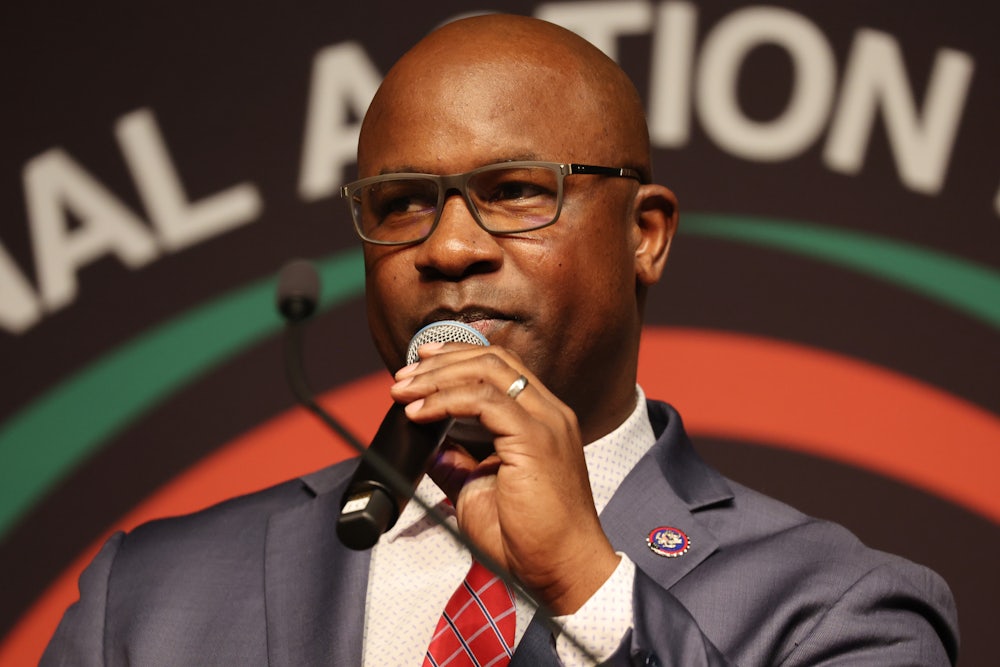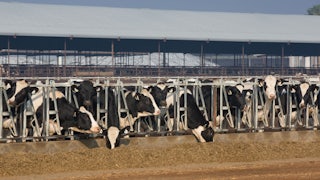As the Inflation Reduction Act progressed through the Senate last week to great acclaim, the House of Representatives quietly received a bill that would address inflation more directly, and could be a critical tool for reducing emissions, too. The Emergency Price Stabilization Act—introduced by New York Congressman Jamaal Bowman—would create a new sub-task force of the existing White House Supply Chain Disruption Task Force to compile data on prices in several key sectors, including energy, transportation, food, housing, health care, and transportation, complete with the subpoena power. The sub-task force would then make policy recommendations, and the bill empowers the White House to set prices in relevant sectors. It builds in broad discretion to interpret those recommendations as they see fit, as well.
“This bill is first and foremost about being able to act quickly to protect people from the kinds of price shocks we are seeing now,” Representative Jamaal Bowman, the bill’s lead sponsor, told me over email. “But it’s also about preparing us to redesign our economy. To hit our climate targets, we’re talking about transforming all of our infrastructure. And we also need a revolution in governance—to make sure things are moving quickly enough, and that we’re doing right by workers and vulnerable people.”
Inflation isn’t a cloud that settles over economies so much as the product of certain things getting more expensive for certain reasons. In recent years, the U.S. government has opted to remedy this with a blunt force approach: By raising interest rates, the U.S. Federal Reserve has reasoned that making dollars more expensive will throttle investment, forcing companies to lay people off or cut wages, thereby lowering demand across the economy and allowing prices to drop. But making people poorer has little bearing on real-world supply chain bottlenecks, the war in Europe, an ongoing pandemic, or a climate crisis—all of which are now affecting global trade. Spending can be used to tackle such problems, as parts of the IRA aspire to, but traditionally the U.S. government has also deployed other tools when faced with world-historic crises: namely, price stabilization policies.
Bowman calls the clean energy investments included in the Inflation Reduction Act “a good start,” though adds that “tax credits are not going to be enough to accomplish a massive, complex transition like the one we’re talking about. We’ll need more planning and coordination from the federal government, and it has to be accountable to the public. In other words, we need democratic control over the economy.” His bill currently has 19 co-sponsors, and the backing of a number of green groups and unions. The AFL-CIO, SEIU, International Brotherhood of Teamsters, National Nurses United, and United Electrical, Radio, and Machine Workers of America are all signed on in support.
For years, economists have held that changing the price of fossil fuels will lead people to abandon higher-carbon goods and activities for lower-carbon ones, like swapping an internal combustion engine car for an electric vehicle or opting to keep the house cooler in the winter. Right now, several countries are living through an open-air experiment of this thesis, a phenomenon economists Isabella Weber and Daniela Gabor have dubbed carbon shock therapy. Spikes in the prices of energy and food have already sparked upheavals from Peru to Pakistan, immiserating millions already on the losing end of vaccine apartheid. Meanwhile, the U.S. government’s favorite tool for reducing inflation—hiking interest rates—threatens to exacerbate the problem, making dollars more scarce, and debts, consequently, harder to pay. The ethical and practical questions that has coursed through the global economy over the last several months raises another question central to the energy transition: Who gets left behind as the productive bases of society change, and more places become harder to inhabit?
“We are in a situation of geopolitical tensions, pandemic, and climate change creating an environment where economic activity isn’t as stable and smooth as it once was,” says Weber, an economist at the University of Massachusetts Amherst who consulted on the bill. In Europe, gas shortages this winter, exacerbated by a potential shut-off of Russian gas, threaten a continent-wide recession. Climate change is making the problem worse. Amid what may be the worst European drought since Henry VIII’s reign, the Rhine river—a key trade corridor—could become unnavigable later this week, including for ships carrying gas and coal being used to offset lost energy from Russian. Dry conditions in Norway are threatening that country’s ability to export its normally abundant hydropower to the rest of the continent.
Weber faced backlash from fellow economists on both sides of the Atlantic for suggesting in a December op-ed for The Guardian that price stabilization policies might be necessary to confront such challenges. That storm, she reasons, was at least in part “an expression of people feeling that things were already changing,” that longstanding dogmas were outliving their usefulness. Months on, several European countries and regions have adopted various types of price stabilization price policies. Spain and Portugal each have price caps for residential gas, and France for electricity. Croatia moved to cap energy price increases to 9.6 percent for electricity and 20 percent for gas. In July, Lower Austria voted to establish a price cap on residential electricity that will start in September and run for a year, mirroring a proposal Weber co-wrote in April to subsidize residential gas bills up to a certain point. “If you are a richer household you will face higher marginal prices, and have an incentive to save,” she told me of the proposal. That way the government won’t “end up subsidizing people to heat their swimming pools.” Several countries are now also calling for a bloc-wide price cap as colder weather looms. The European Commission is also debating a gas buyers’ cartel, using their combined purchasing power to limit wholesale prices.
Price controls were also once relatively commonplace here, employed in times of war and to moderate energy prices. At its peak, the World War II-era Office of Price Administration had a staff of 250,000 monitoring and administering prices across virtually the entire economy, and employed twice as many economists as the Treasury Department. Historian Andrew Elrod explains that price controls in the U.S., save for a few standing agencies, have typically been emergency measures requiring regular re-authorization from Congress. “Generally when we talk about emergency price stabilization, we’re talking about the general granting of power to fix legal ceilings, and that has always come with an expiration date,” he told me. Over the last several decades, those powers have eroded, leaving presidents with few tools to remedy rising prices in specific sectors. “If a company disregards the power of the bully pulpit,” as oil refiners have in response to the White House’s letter to them about price gouging this spring, “there’s not a lot that the president can do to directly prevent profiteering. You’d have to have some basis to bring the company before a public body or a court to say that there’s been a violation of law. That’s why you need a law [authorizing the use of price controls],” said Elrod, who also worked on the bill.
Price controls aren’t intended to be used in a vacuum, but as part of a broader array of policies. In the case of energy, that also means lowering demand for energy and fossil fuels, in particular. Germany rolled out an affordable rail pass aimed at encouraging people to drive and fly less. Spain has mandated that air conditioners in public places not be set below 80 degrees Fahrenheit. Here, demand reduction remains something of a political third rail—and options for executing it are somewhat limited. “On the demand side, for things like gasoline, there are just certain limits that are hard to overcome. As a European living in the U.S., I never had a car before moving here,” Weber, who’s German, told me. “You can’t tell people to go take public transport if there is no public transport. What you need is investment into infrastructure that provides real alternatives so that you can cut down consumption.”
Proposals for bringing down gasoline prices in the United States—and freeing up supplies to go to Europe—have tended to focus on the supply side of the equation. The think tank Employ America, for instance, suggests using an ambitious suite of existing federal authorities—including the Treasury Department’s Exchange Stabilization Fund and the Strategic Petroleum Reserve—to guarantee stable oil prices and provide drillers with the confidence needed to invest in new production, and lower prices accordingly. The relationship between new drilling and prices is a somewhat murky one, though. Murkier still is the question of whether oil executives—many of them staunchly right-wing, with an ornery dislike for Democratic presidents—will be responsive to such incentives. Even amid high prices, they’ve opted to keep funneling money back to shareholders, who in turn are wary of returning to the freewheeling days of the shale boom, when companies lit their money on fire to expand production as rapidly as possible—profitability be damned. It’s a rare case where the interests of fossil fuel investors are aligned with those of the planet.
Despite talk of corporate price gouging and “Putin’s Price Hike,” there hasn’t yet been much of a concerted effort on the part of the government to determine precisely how supply and demand, and greed and speculation, are affecting prices at the pump. The information gathering process included in the Emergency Price Stabilization Act, experts say, is a crucial step not just for understanding how prices are generated, but for building the case to stabilize them. Much of the back-and-forth over what to do about inflation has consisted of quibbling among economists and policymakers about just how much blame to place on corporate profiteering. When it comes to gas prices, at least, how prices at the pump are generated is something of a black box: refiners and retailers (i.e. gas stations) have some discretion. The market price of oil is a big factor, too. But even that’s subject to deals among commodity traders whose activities take place beyond the grasp of just about every regulator on the planet.
As price controls have fallen out of favor with economists and policymakers over the last several decades, the government’s capacity to implement them—and even to collect the requisite data—has atrophied. The Emergency Price Stabilization Act is an opening bid to rebuild those tools and skills, and prepare for the many shocks to come this century, including potential explosions in the price of critical minerals key to the energy transitions. In addition to the new sub-task force, the bill would require the National Economic Council to study how price management and green public investment can be mutually reinforcing. The process of understanding and administering prices should also, Bowman emphasized, be democratic, not just technocratic. One of the reasons price controls were so successful during World War II, he says, “is that you had a big mobilization of the public. Everyday people gathered and shared information on prices that were burdensome or unfair, and helped make sure controls were being implemented properly.” Technology would make that easier today, “but we would still need people to be engaged on the ground in their communities.”
That process of rebuilding governing capacities, Bowman argues, “will give us knowledge and skills that our government has either forgotten or failed to seek. We can use that to not only bring emissions down, but also prioritize people over profits in general.”
This piece has been updated.










